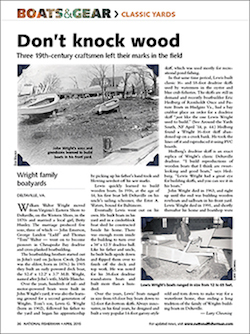Fishermen who stop by the National Fisherman booth at the Maine Fishermen's Forum in Rockport, Maine, are always drawn to look at the photos from our archives that we display there. Sometimes fishermen recognize the boats or the people depicted in those snapshots, and share their recollections with us. That's good stuff.
Those photos offer a glimpse of what fishing was like in the old days and honor the industry's rich past. We do likewise in our April issue, which features one article about several classic boats ("Vintage vessels," beginning on page 32) and another spotlighting three notable boatbuilders ("Don't knock wood," page 36).
 Boats and Gear Editor Michael Crowley dipped into the National Fisherman and Atlantic Fisherman archives to spotlight five venerable vessels. Featured are the 66-foot Katherine, built in 1975 at the Newbert & Wallace shop in Thomaston, Maine; the sail-powered 123-foot L.A. Dunton, which fished the Grand Banks in the early 1920s; the 76-foot shrimper Chris-Corey, built in 1968, which boasted creature comforts for the crew; the steam-powered trawler Kingfisher, which was built in 1919; and the 64-foot Grayling, built in 1915, which carried Maine sardines for nearly 70 years.
Boats and Gear Editor Michael Crowley dipped into the National Fisherman and Atlantic Fisherman archives to spotlight five venerable vessels. Featured are the 66-foot Katherine, built in 1975 at the Newbert & Wallace shop in Thomaston, Maine; the sail-powered 123-foot L.A. Dunton, which fished the Grand Banks in the early 1920s; the 76-foot shrimper Chris-Corey, built in 1968, which boasted creature comforts for the crew; the steam-powered trawler Kingfisher, which was built in 1919; and the 64-foot Grayling, built in 1915, which carried Maine sardines for nearly 70 years.
In the other story, longtime NF contributor Larry Chowning shares his love and knowledge of Chesapeake Bay boatbuilding in his profile of the Wright family boatyards in Deltaville, Va. Crowley contiributes a piece on Alvin Beal's Boatshop, located on Maine's Beals Island, and Charlie Ess, our North Pacific bureau chief, writes about Louis Johnson's Ketchikan, Alaska yard.
I think the qualities that made these boatbuilders great are found throughout the fishing industry. It's clear to me that these men loved building boats as much as their customers loved fishing; boatbuilding was their lifelong endeavor.
They soaked up the boatbuilding knowledge they gained from the master craftsmen who preceded them. These talented builders were able to use that knowledge to create beautiful and durable vessels.
But they also had the vision to respond to the fishing demands of their time, and possessed the ability to improve upon past ideas and bring new ones to life. Those qualities are as valuable today as they were in the fishing past.







